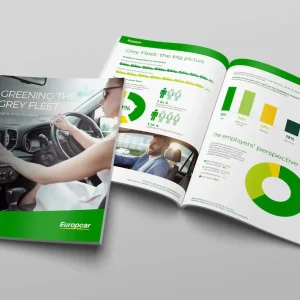Although the Energy Saving Trust doesn’t have its own fleet per se, the organisation helps hundreds of fleets per year to decarbonise transport and deliver cleaner air.
At the helm is Tim Anderson, who joined the Energy Saving Trust (EST) in 2007, and now leads its low-carbon transport portfolio, the main goal of which is addressing poor air quality in the transport sector.
Anderson is well versed in fleets, having previously worked in daily rental and directly managing fleets, including Virgin Media, then NTL, directly in charge of a large fleet of around 7,000 vehicles.
He lives in Ashby-de-la-Zouch in the East Midlands, but splits his time between the EST offices in London’s Kings Cross and Edinburgh. Although driving or flying to these offices would be convenient, these options are off-limits to the clean energy company’s head of transport. “We absolutely don’t fly, particularly domestically, because of who we are, a respected and trusted voice on energy efficiency and clean energy solutions,” he tells us. “Sometimes the pragmatic choice is to drive to a train station and get public transport from there,” Anderson says.
He explains the mission for EST is really simple – “to tackle the climate emergency.” The reason the mission is so broad is because the organisation goes about it in many different ways. We help consumers by offering support and advice around energy efficiency and the ways individuals can reduce their carbon footprint at home.
“In Scotland, we offer a number of incentives in the form of interest-free loans that the Scottish government funds to help consumers buy electric vehicles and bikes. We also have the ULEV support fund in Scotland, where we provide a small incentive to help people to scrap their older vehicles,” Anderson says.
The transport team of 55 people concentrates on helping fleets, local authorities and other
public sector organisations to become greener by using Anderson’s previous fleet management experience.
“With my extensive experience in overseeing the fleet operations of a telecommunications company, I have a deep understanding of the requirements, obstacles, and daily management of fleets. This encompasses responsibilities like ensuring safety and duty of care, procuring suitable vehicles, and leveraging company cars as instruments for retaining and attracting the ideal talent, rather than just facilitating transportation,” he explains.
During his previous tenure as a fleet manager, Anderson recalls that environmental concerns were not as high on the agenda for fleets as they are today. In recent years, despite reductions in government funding affecting the organisation’s ability to assist them, the EST has witnessed a growing interest from fleets seeking to reduce their environmental footprint. The organisation remains committed to aiding more companies in adopting transformative practices, particularly given the ambitious government goal of achieving net zero carbon emissions by 2050.
Back in England, the EST is also overseeing the local electric vehicle infrastructure LEVI fund, which aids local authorities in planning and deploying charging infrastructure for residents lacking off-street parking. “The fund includes support for chargepoint deployment, and we’re the leading support organisation for it,” notes Anderson. This amounts to more than £300 million in government funding to assist local authorities in implementing EV charging infrastructure throughout their regions, with a particular focus on residents without driveways.
A new approach
For nearly two decades, the core focus of the EST has been offering impartial guidance and advice to hundreds of fleets each year. “Until recently, this service was financially supported by the Department for Transport for England, but regrettably, that funding has been discontinued,” Anderson admits.
Despite this, the organisation still promises to provide fleets with impartial advice as they have done in the past. “We don’t have an axe to grind and we’re not trying to sell or lease vehicles, which makes us different from a consulting service provided by a leasing company,” says Anderson. “We are still very much committed to delivering impartial guidance, but there is now a fee associated with it. Our commitment to independence remains unwavering, as it is one of our core values.”
Anderson adds that his team is always happy to talk to fleets about their challenges and continue to help them with a roadmap and implementing measures to decarbonise, in particular when it comes to electrification, which he describes as the “big ticket item” now and moving forward. “I’ve been doing
this for a long time,” says Anderson “and the decarbonisation of fleets via electrification has shifted from niche to mainstream.”
For company car drivers, he notes that it’s a no-brainer to choose an EV over a petrol or diesel. “It’s pretty much job done on our end – we no longer need to convince drivers to make the move – but I can’t take all of the credit for that, because BIK taxation in recent years has played a huge part in motivating company car drivers to go electric and we’ve seen them do that in very large numbers,” he explains.
Anderson and his team are finding that rather than the company car user chooser fleet, they’re seeing more interest in decarbonising from local authority fleets. “These fleets are asking us to look at everything from large refuse vehicles down to microcollection vehicles that go around emptying bins in parks, vans to cherry pick streetlights and everything in between,” he says, and explains that the heavier vehicle sector is proving much harder to decarbonise than cars, due to a lack of electric options on offer.
Anderson details how the EST operates, beginning with an initial meeting with one of its fleet support managers to understand the fleet’s needs and objectives, and current fleet infrastructure, costs and processes.
He says, “Once we’ve met, we will strive to understand the requirements of the fleet and their ambitions. Then, we will collect the fleet list and all of the data they have available, particularly around telematics, that will help us understand what opportunities there are for decarbonisation and electrification so we can provide a set of proposals around what the fleet can do differently and the cost implications of making those changes.”
Grey matter
Of particular interest to Anderson and his team is addressing the decarbonisation of the grey fleet. “We’ve been banging the drum on this year after year with mixed success,” he explains, “due to many challenges we’re facing to get the message across to organisations.”
Although he describes grey fleet as an easy target for decarbonisation, as they are often older, more polluting, less safe and less efficient, they are often seen as an addition to a person’s salary and therefore have proven difficult to convince fleets to remove. Anderson explains, “I am trying to raise awareness of grey fleet once again to really get the issue back on the agenda. It feels like it was one of those things during Covid that was put into the ‘too hard to deliver’ box so it was forgotten. But it’s still a big challenge and something I believe should be brought to the fore.”
Committed to net zero
Anderson believes that by and large, the organisations the EST speaks to are supportive of legislation that takes the UK towards the net-zero target by 2050. “To get there, we had the target of the current banning of sales of petrol and diesel vehicles by 2030, which has now been pushed back to 2025 by the current Prime Minister,” he explains. “Ironically, businesses don’t want legislation to move; they’re happy to understand and commit to the roadmap towards net zero.”
According to Anderson, electric cars are the future for fleet. “The technology is improving, as is the ability to charge them, discharge them and use cars for storage – all of which will play a part in making electric the future for cars. For heavy vehicles, it’s a bit more challenging, due to their weight and the distances they’re often required to travel, so that’s where we will probably see a divergence of technology.”
Although Anderson doesn’t see the adoption of electric cars as a barrier for fleets now, their charging infrastructure remains a challenge. He says, “This is something we’re actively working with the government to help solve, but it’s still always going to be a challenge when people can’t charge their vehicle as quickly as they want to where and when they want to and that’s a huge logistical issue.”
Anderson has faith that an active private sector through the chargepoint operators and a motivated government will continue to improve access to charge points. Anderson notes, “We need to be getting the infrastructure right so drivers don’t have to even think about it and just charge when they need to.”
However, the biggest challenge for the Trust currently is the prioritisation of decarbonisation on the government agenda. Anderson explains, “The politics surrounding net zero are becoming quite toxic, leading to a diversion of funds, as we have witnessed first-hand in our organisation recently. Our ability to help everyone in their decarbonisation journey has been limited, but we’ve made progress, and helped many fleets and I am still positive that in the end, we will make good and positive choices when it comes to decarbonisation, and often that comes out in the ballot box.”
The current state of politics has led the future success of the EST towards its ability to continually adapt. As a not-for-profit, Anderson explains that any surplus money surplus is invested back into its mission to tackle the climate emergency. “We have to change constantly because politics changes constantly. We need to always find a new solution in a changing marketplace,” he concludes.





